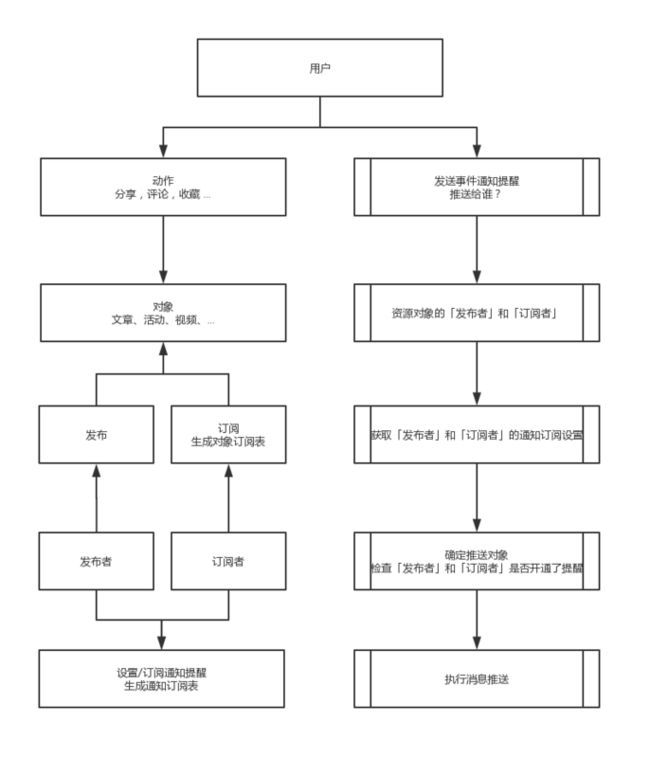本篇主要明确消息通知系统的概念和具体实现,包括数据库设计、技术方案、逻辑关系分析等。消息通知系统是一个比较复杂的系统,这里主要分析站内消息如何设计和实现。
我们常见的消息推送渠道有以下几种:
- 设备推送
- 站内推送
- 短信推送
- 邮箱推送
我们常见的站内通知有以下几种类别:
- 公告 Announcement
-
提醒 Remind
- 资源订阅提醒「我关注的资源有更新、评论等事件时通知我」
- 资源发布提醒「我发布的资源有评论、收藏等事件时通知我」
- 系统提醒「平台会根据一些算法、规则等可能会对你的资源做一些事情,这时你会收到系统通知」
- 私信 Mailbox
以上三种消息有各自特点,实现也各不相同,其中「提醒」类通知是最复杂的,下面会详细讲。
数据模型设计
公告
公告是指平台发送一条含有具体内容的消息,站内所有用户都能收到这条消息。
方案一:【适合活跃用户在5万左右】
公告表「notify_announce」
表结构如下:
id: {type: 'integer', primaryKey: true, autoIncrement:true} //公告编号;
senderID: {type: 'string', required: true} //发送者编号,通常为系统管理员;
title: {type: 'string', required: true} //公告标题;
content: {type: ’text', required: true} //公告内容;
createdAt: {type: 'timestamp', required: true} //发送时间;用户公告表「notify_announce_user」
表结构如下:
id: {type: 'integer', primaryKey: true, autoIncrement:true} //用户公告编号;
announceID: {type: 'integer'} //公告编号;
recipientID: {type: 'string', required: true} //接收用户编号;
createdAt:{type: 'timestamp', required: true} //拉取公告时间;
state: {type: 'integer', required: true} //状态,已读|未读;
readAt:{type: 'timestamp', required: true} //阅读时间;平台发布一则公告之后,当用户登录的时候去拉取站内公告并插入notify_announce_user表,这样那些很久都没登陆的用户就没必要插入了。「首次拉取,根据用户的注册时间;否则根据notify_announce_user.createdAt即上一次拉取的时间节点获取公告」
方案二:【适合活跃用户在百万-千万左右】
和方案一雷同,只是需要把notify_announce_user表进行哈希分表,需事先生成表:notify_announce_
用户公告表「notify_announce_
表结构如下:
id: {type: 'integer', primaryKey: true, autoIncrement:true} //用户公告编号;
announceID: {type: 'integer'} //公告编号;
recipientID: {type: 'string', required: true} //接收用户编号;
createdAt:{type: 'timestamp', required: true} //拉取公告时间;
state: {type: 'integer', required: true} //状态,已读|未读;
readAt:{type: 'timestamp', required: true} //阅读时间;提醒
提醒是指「我的资源」或「我关注的资源」有新的动态产生时通知我。提醒的内容无非就是:
「someone do something in someone's something」
「谁对一样属于谁的事物做了什么操作」
常见的提醒消息例子,如:
XXX 关注了你 - 「这则属于资源发布提醒」
XXX 喜欢了你的文章 《消息通知系统模型设计》 - 「这则属于资源发布提醒」
你喜欢的文章《消息通知系统模型设计》有新的评论 - 「这则属于资源订阅提醒」
你的文章《消息通知系统模型设计》已被加入专题 《系统设计》 - 「这则属于系统提醒」
小明赞同了你的回答 XXXXXXXXX -「这则属于资源发布提醒」
最后一个例子中包含了消息的生产者(小明),消息记录的行为(赞同),行为的对象(你的回答内容)
分析提醒类消息的句子结构:
someone = 动作发起者,标记为「sender」
do something = 对资源的操作,如:评论、喜欢、关注都属于一个动作,标记为「action」
something = 被作用对象,如:一篇文章,文章的评论等,标记为「object」
someone's = 动作的目标对象或目标资源的所有者,标记为「objectOwner」
总结:sender 和 objectOwner 就是网站的用户,object 就是网站资源,可能是一篇文章,一条文章的评论等等。action 就是动作,可以是赞、评论、收藏、关注、捐款等等。
提醒设置
提醒通常是可以在「设置-通知」里自定义配置的,用户可以选择性地「订阅」接收和不接收某类通知。
呈现在界面上是这样的:
通知设置
我发布的 publish
文章
被 评论 是/否 通知我
被 收藏 是/否 通知我
被 点赞 是/否 通知我
被 喜欢 是/否 通知我
被 捐款 是/否 通知我
我订阅的 follow
文章
有 更新 是/否 通知我
被 评论 是/否 通知我订阅
一般系统默认是订阅了所有通知的。系统在给用户推送消息的时候必须查询通知「订阅」模块,以获取某一事件提醒消息应该推送到哪些用户。
也就是说「事件」和「用户」之间有一个订阅关系。
那么接下来我们分析下「订阅」有哪些关键元素:
比如我发布了一篇文章,那么我会订阅文章《XXX》的评论动作,所以文章《XXX》每被人评论了,就需要发送一则提醒告知我。
分析得出以下关键元素:
- 订阅者「subscriber」
- 订阅的对象「object」
- 订阅的动作「action」
- 订阅对象和订阅者的关系「objectRelationship」
什么是订阅的目标关系呢?
拿知乎来说,比如我喜欢了一篇文章,我希望我订阅这篇文章的更新、评论动作。那这篇文章和我什么关系?不是所属关系,只是喜欢。
- objectRelationship = 我发布的,对应着 actions = [评论,收藏]
- objectRelationship = 我喜欢的,对应着 actions = [更新,评论]
讲了那么多,现在来构建「提醒」的数据结构该吧!
提醒表「notify_remind」
表结构如下:
id: {type: 'integer', primaryKey: true, autoIncrement:true} //主键;
remindID: {type: 'string', required: true} //通知提醒编号;
senderID: {type: 'string', required: true} //操作者的ID,三个0代表是系统发送的;
senderName: {type: 'string’, required: true} //操作者用户名;
senderAction: {type: 'string', required: true} //操作者的动作,如:赞了、评论了、喜欢了、捐款了、收藏了;
objectID: {type: 'string', required: true}, //目标对象ID;
object: {type: 'string', required: false}, //目标对象内容或简介,比如:文章标题;
objectType: {type: 'string', required: true} //被操作对象类型,如:人、文章、活动、视频等;
recipientID: {type: 'string’} //消息接收者;可能是对象的所有者或订阅者;
message: {type: 'text', required: true} //消息内容,由提醒模版生成,需要提前定义;
createdAt:{type: 'timestamp', required: true} //创建时间;
status:{type: 'integer', required: false} //是否阅读,默认未读;
readAt:{type: 'timestamp', required: false} //阅读时间;假如:特朗普关注了金正恩,以下字段的值是这样的
senderID = 特朗普的ID
senderName = 特朗普
senderAction = 关注
objectID = 金正恩的ID
object = 金正恩
objectType = 人
recipientID = 金正恩的ID
message = 特朗普关注了金正恩
这种情况objectID 和 recipientID是一样的。这里需要特别说下消息模版,模版由「对象」、「动作」和「对象关系」构成唯一性。
通知提醒订阅表「notify_remind_subscribe」
表结构如下:
id: {type: 'integer', primaryKey: true, autoIncrement:true} //订阅ID;
userID: {type: 'string', required: true},//用户ID,对应 notify_remind 中的 recipientID;
objectType: {type: 'string', required: true} //资源对象类型,如:文章、评论、视频、活动、用户;
action: {type: 'string', required: true} //资源订阅动作,多个动作逗号分隔如: comment,like,post,update etc.
objectRelationship: {type: 'string', required: true} //用户与资源的关系,用户发布的published,用户关注的followed;
createdAt:{type: 'timestamp', required: true} //创建时间;特别说下「objectRelationship」字段的作用,这个字段用来区分「消息模版」,为什么呢?因为同一个「资源对象」和「动作」会有两类订阅者,一类是该资源的Owner,另一类是该资源的Subscriber,这两类人收到的通知消息内容应该是不一样的。
聚合
假如我在抖音上发布了一个短视频,在我不在线的时候,被评论了1000遍,当我一上线的时候,应该是收到一千条消息,类似于:「* 评论了你的文章《XXX》」? 还是应该收到一条信息:「有1000个人评论了你的文章《XXX》」?
当然是后者更好些,要尽可能少的骚扰用户。
消息推送
订阅表一共有两张噢,一张是「通知订阅表」、另一张是用户对资源的「对象订阅表」。
具体实现就不多讲了,配合这张图,理解上面讲的应该不会有问题了。
私信
通常私信有这么几种需求:
- 点到点:用户发给用户的站内信,系统发给用户的站内信。「1:1」
- 点到多:系统发给多个用户的站内信,接收对象较少,而且接收对象无特殊共性。「1:N」
- 点到面:系统发给用户组的站内信,接收对象同属于某用户组之类的共同属性。「1:N」
- 点到全部:系统发给全站用户的站内信,接收对象为全部用户,通常为系统通知。「1:N」
这里主要讲「点到点」的站内信。
私信表「notify_mailbox」
表结构如下:
id: {type: 'integer', primaryKey: true, autoIncrement:true} //编号;
dialogueID: {type: 'string', required: true} //对话编号;
senderID: {type: 'string', required: true} //发送者编号;
recipientID: {type: 'string', required: true} //接收者编号;
messageID: {type: 'integer', required: true} //私信内容ID;
createdAt:{type: 'timestamp', required: true} //发送时间;
state: {type: 'integer', required: true} //状态,已读|未读;
readAt:{type: 'timestamp', required: true} //阅读时间;Inbox
私信列表
select * from notify_inbox where recipientID="uid" order by createdAt desc
对话列表
select * from notify_inbox where dialogueID=“XXXXXXXXXXXX” and (recipientID=“uid” or senderID="uid") order by createdAt asc私信回复时,回复的是dialogueID
Outbox
私信列表
select * from notify_inbox where senderID="uid" order by createdAt desc
对话列表
select * from notify_inbox where dialogueID=“XXXXXXXXXXXX” and (senderID=“uid” or recipientID="uid") order by createdAt asc私信内容表「notify_inbox_message」
表结构如下:
id: {type: 'integer', primaryKey: true, autoIncrement:true} //编号;
senderID: {type: 'string', required: true} //发送者编号;
content: {type: 'string', required: true} //私信内容;
createdAt:{type: 'timestamp', required: true}参考
消息系统设计与实现
通知系统设计
